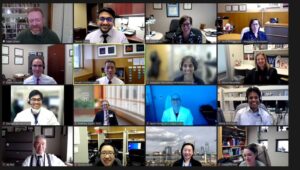When hope was in short supply, this Erdheim-Chester disease patient found a medical team that went above and beyond, bringing him the hope he needed to gain a life he could embrace.
By Adam Green
In July of 2017, I received a phone call that would change my life.
I’d spent the previous three years bouncing from specialist to specialist; sitting in exam rooms with an unusual constellation of symptoms and abnormal laboratory results while physicians scratched their heads. They’d offer a few thoughts while they scribbled their notes, then they’d shake my hand and refer me to another specialist. Maybe they would be able to give me answers.

Adam meets with a team of doctors working on his treatment plan.
Three years of searching for those answers landed me at the Mayo Clinic in Rochester, Minnesota. The “Miracle in the Cornfield.” A place where people from every country on the globe come looking for answers. And in 2017 it was the Mayo Clinic calling my phone. Finally, they had some answers for me.
I was diagnosed with a rare form of cancer called Erdheim-Chester Disease, or ECD for short. It’s a blood cancer, and while all ECD patients tend to share some common symptoms and manifestations on imaging tests, etc., the severity of the disease can range from relatively benign to life-threatening.
I consider myself lucky for being diagnosed when I was. In 2008, Kathy Brewer established the Erdheim-Chester Disease Global Alliance (ECDGA). She’d lost her husband the year prior after a long battle with illness, and it was only after the autopsy that a diagnosis was made. It was discovered that ECD was the disease he’d been suffering from. ECDGA has not only brought increased awareness of the disease to the medical community, but its support has also led to significant advances in understanding how the disease works and how to treat it.
The team at Mayo Clinic wasted no time in getting me started on treatment. When I wouldn’t respond to one treatment, they would regroup and come up with another approach. Over the course of the next four years Drs. Jithma Abeykoon, Gaurav Goyal, Ronald Go, and Matthew Koster collaborated with physicians and experts, both at Mayo and around the world, in an effort to find a treatment that would work for me. After performing next-generation sequencing on a tissue biopsy, they discovered what they believed to be an activating mutation that could be targeted with chemotherapy. I started this treatment in July of 2021, and I’m happy to report that in April of 2022 I had a complete clinical, and near-complete radiological, response.
I have my life back.
It’s impossible for me to capture with mere words the gratitude and awe I have for the doctors and medical professionals who’ve cared for me since I first became ill — since I had that first twinge of “something isn’t right.”
When I was at my lowest and most afraid, with my symptoms worsening and treatment not working, Dr. Abeykoon looked at me and told me to have “hope” — so I clung to hope. And now I sit here, full of a different kind of hope, one that stretches far into the future, the impossible suddenly possible.
“Miracle in the cornfield,” indeed.
April 8, 2022








